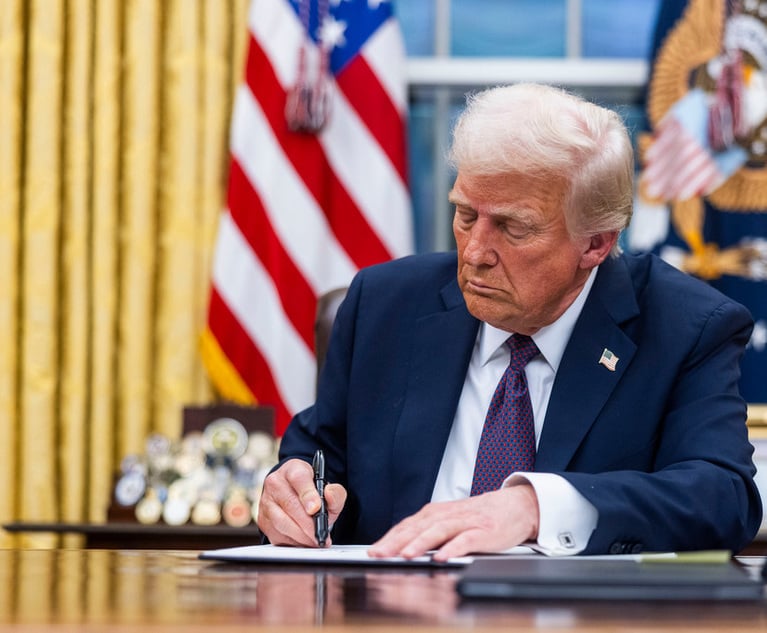Another Major Shooting Unfolds as Justices Weigh Latest Firearms Case
The U.S. Supreme Court's conference on Thursday includes a challenge to concealed-carry restrictions in California. The Orlando nightclub shooting in June 2016 occurred days before the court declined to hear a challenge to post-Sandy Hook gun laws.
June 14, 2017 at 01:58 PM
11 minute read
A year after the deadliest mass shooting in U.S. history, at an Orlando nightclub, another major shooting—Wednesday's gunfire that injured a member of Congress—unfolded as the U.S. Supreme Court prepares to consider the latest challenge to gun regulations.
The justices on Thursday are scheduled to review the case Peruta v. California, a challenge to restrictions in California against carrying concealed firearms in public. The U.S. Court of Appeals for the Ninth Circuit in June 2016 said there is no Second Amendment protection to such carrying of a gun.
Last June, the Orlando massacre at the Pulse club, which killed 49 people and wounded 58, happened just days before the justices took their first look at a challenge to Connecticut's ban on military-style firearms. The high court subsequently declined to hear the case, leaving in place restrictions adopted after the shooting at Sandy Hook Elementary School killed 20 children and six teachers.
Whether Peruta will share the same fate as the Connecticut case is difficult to predict. The California case has been listed for the justices' private conference 11 times and rescheduled four times since the petition, brought by Kirkland & Ellis partner Paul Clement, was filed on Jan. 12.
What is clear, however, is that the justices have been reluctant to step back into the Second Amendment debate over gun regulation. They have turned away at least 10 challenges to state and local gun regulations since their two landmark decisions in 2008 in District of Columbia v. Heller and two years later in McDonald v. City of Chicago.
In Heller, a 5-4 court held that the Second Amendment guarantees an individual right to possess a handgun for self-defense in the home. The 5-4 majority in McDonald applied the Second Amendment to the states.
Only three justices have dissented when the high court has turned away new gun regulation challenges: the late Justice Antonin Scalia, and Justices Clarence Thomas and Samuel Alito Jr.
In 2015, when the justices denied review of a challenge to Highland Park, Illinois' ban on assault weapons, Thomas dissented. He wrote then: “Roughly 5 million Americans own AR-style semiautomatic rifles. The overwhelming majority of citizens who own and use such rifles do so for lawful purposes, including self-defense and target shooting. Under our precedents, that is all that is needed for citizens to have a right under the Second Amendment to keep such weapons.”
California regulates open carry and concealed carry of guns in public. Open carry is generally prohibited, with a few exceptions. Anyone applying for a concealed-carry license must show, among other requirements, that “good cause” exists for the license. The state's counties may decide what constitutes “good cause.”
In Peruta, Clement argues that the San Diego sheriff's interpretation of “good cause” is so restrictive that the typical law-abiding resident in the county cannot get a concealed-carry license. “And because California law prohibits openly carrying a handgun outside the home, the result is that the typical law-abiding resident cannot bear a handgun for self-defense outside the home at all.”
The en banc Ninth Circuit narrowly examined “whether the Second Amendment protects, in any degree, the ability to carry concealed firearms in public.” It did not reach the question whether the right to bear arms existed outside of the home.
The justices also have pending a petition filed by the Trump administration's U.S. Justice Department that seeks to overturn a Third Circuit decision. The case, Sessions v. Binderup, is on the court's Thursday conference list.
The appeals court last year said the federal ban on felons possessing guns violated the Second Amendment rights of two men convicted of nonviolent misdemeanor offenses. The case has been listed six times for the court's private conference.
This content has been archived. It is available through our partners, LexisNexis® and Bloomberg Law.
To view this content, please continue to their sites.
Not a Lexis Subscriber?
Subscribe Now
Not a Bloomberg Law Subscriber?
Subscribe Now
NOT FOR REPRINT
© 2025 ALM Global, LLC, All Rights Reserved. Request academic re-use from www.copyright.com. All other uses, submit a request to [email protected]. For more information visit Asset & Logo Licensing.
You Might Like
View All
Is 1st Circuit the New Center for Trump Policy Challenges?

Insurance Policies Don’t Cover Home Depot's Data Breach Costs, 6th Circuit Says

'Religious Discrimination'?: 4th Circuit Revives Challenge to Employer Vaccine Mandate
2 minute read
Standing Spat: Split 2nd Circuit Lets Challenge to Pfizer Diversity Program Proceed
Trending Stories
Who Got The Work
J. Brugh Lower of Gibbons has entered an appearance for industrial equipment supplier Devco Corporation in a pending trademark infringement lawsuit. The suit, accusing the defendant of selling knock-off Graco products, was filed Dec. 18 in New Jersey District Court by Rivkin Radler on behalf of Graco Inc. and Graco Minnesota. The case, assigned to U.S. District Judge Zahid N. Quraishi, is 3:24-cv-11294, Graco Inc. et al v. Devco Corporation.
Who Got The Work
Rebecca Maller-Stein and Kent A. Yalowitz of Arnold & Porter Kaye Scholer have entered their appearances for Hanaco Venture Capital and its executives, Lior Prosor and David Frankel, in a pending securities lawsuit. The action, filed on Dec. 24 in New York Southern District Court by Zell, Aron & Co. on behalf of Goldeneye Advisors, accuses the defendants of negligently and fraudulently managing the plaintiff's $1 million investment. The case, assigned to U.S. District Judge Vernon S. Broderick, is 1:24-cv-09918, Goldeneye Advisors, LLC v. Hanaco Venture Capital, Ltd. et al.
Who Got The Work
Attorneys from A&O Shearman has stepped in as defense counsel for Toronto-Dominion Bank and other defendants in a pending securities class action. The suit, filed Dec. 11 in New York Southern District Court by Bleichmar Fonti & Auld, accuses the defendants of concealing the bank's 'pervasive' deficiencies in regards to its compliance with the Bank Secrecy Act and the quality of its anti-money laundering controls. The case, assigned to U.S. District Judge Arun Subramanian, is 1:24-cv-09445, Gonzalez v. The Toronto-Dominion Bank et al.
Who Got The Work
Crown Castle International, a Pennsylvania company providing shared communications infrastructure, has turned to Luke D. Wolf of Gordon Rees Scully Mansukhani to fend off a pending breach-of-contract lawsuit. The court action, filed Nov. 25 in Michigan Eastern District Court by Hooper Hathaway PC on behalf of The Town Residences LLC, accuses Crown Castle of failing to transfer approximately $30,000 in utility payments from T-Mobile in breach of a roof-top lease and assignment agreement. The case, assigned to U.S. District Judge Susan K. Declercq, is 2:24-cv-13131, The Town Residences LLC v. T-Mobile US, Inc. et al.
Who Got The Work
Wilfred P. Coronato and Daniel M. Schwartz of McCarter & English have stepped in as defense counsel to Electrolux Home Products Inc. in a pending product liability lawsuit. The court action, filed Nov. 26 in New York Eastern District Court by Poulos Lopiccolo PC and Nagel Rice LLP on behalf of David Stern, alleges that the defendant's refrigerators’ drawers and shelving repeatedly break and fall apart within months after purchase. The case, assigned to U.S. District Judge Joan M. Azrack, is 2:24-cv-08204, Stern v. Electrolux Home Products, Inc.
Featured Firms
Law Offices of Gary Martin Hays & Associates, P.C.
(470) 294-1674
Law Offices of Mark E. Salomone
(857) 444-6468
Smith & Hassler
(713) 739-1250










